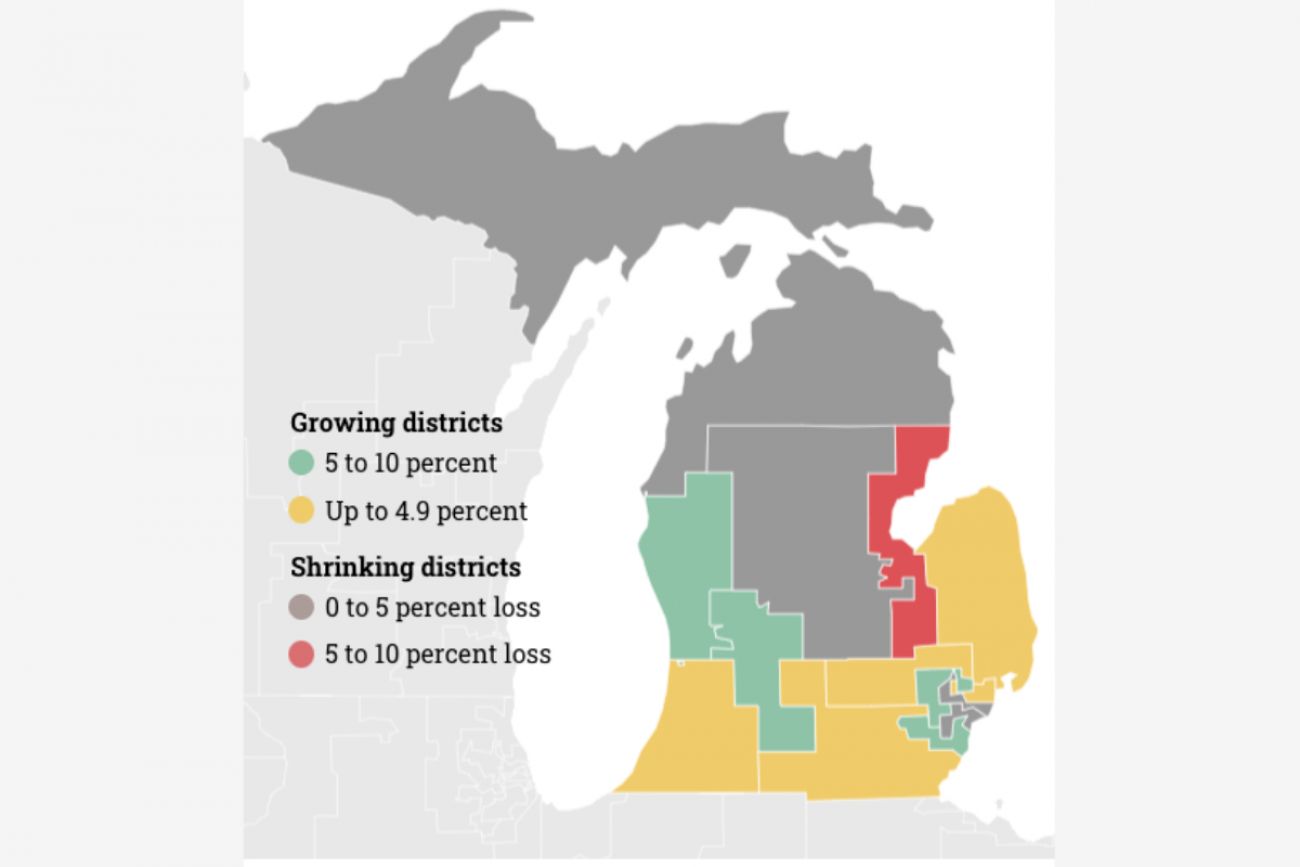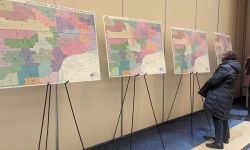Census changes may spell trouble for Michigan Democrats as redistricting starts

LANSING — Heavy population losses in Detroit, Flint and other cities could put Democrats at a disadvantage when new congressional and state legislative districts are drawn this year.
Democrats represent the three congressional districts that lost the greatest share of residents in the 2020 U.S. Census, the 13th and 14th in southeast Michigan and 5th on the state’s east side.
But statewide population changes — growth on the west side, stagnation north of Lansing and decline in the Thumb — mean that districts in GOP strongholds also will be dramatically reshaped when the Michigan Independent Citizens Redistricting Commission crafts new political maps from census data this year.
Related:
- Census losses could squeeze northern Michigan, Detroit as redistricting begins
- Census 2020: Look up population changes in your Michigan community
- Census takeaways: West Michigan gains, Detroit & U.P. lose, state more diverse
Michigan’s congressional representation is now divided 7-7 between Democrats and Republicans, but the state will lose a seat next year because of slow state growth, falling to 13.
“We should expect the new districts to change, because the process has changed completely and the commission is not really supposed to use the current districts as a model,” said Matt Grossmann, the director of the Institute for Public Policy and Social Research at Michigan State University.
Among congressional districts, the 5th Congressional District, represented by U.S. Rep. Dan Kildee, D-Flint Township, had the steepest population decline — 5 percent or 90,466 residents.
Two districts covering parts of Detroit — the 13th represented by Rashida Tlaib, D-Detroit, and 14th represented by Brenda Lawrence, D-Southfield — lost 4.4 percent and 2.1 percent of their populations respectively.
“If I were Dan Kildee, I would be very concerned about my future seat in Congress,” said Jamie Roe, a Republican strategist.
Kildee’s seat covers Flint, Saginaw, Bay City and surrounding counties, an area that now has 670,703 residents. After redistricting, congressional seats must average 761,169 residents.
Political geography is not on Democrats’ side in the area: In 2020, four out of the six counties in Kildee’s district — Arenac, Bay, Iosco, and Tuscola — voted for President Donald Trump. Almost all of the counties to the west, north and east of the 5th District are also Republican strongholds, while the south, Oakland County, is already carved into four congressional districts.
Another complication: Michigan has two majority-minority districts protected by the Voting Rights Act of 1965, and the redistricting commission has said it is committed to ensuring racial minorities have fair representation.
Both of the majority-minority districts, the 13th and the 14th, lost residents, driven largely by the 93,000 Black residents that the Census says left Detroit from 2010 to 2020.
Many inner-ring suburbs, including Eastpointe, Redford Township, Southfield and Roseville, became more diverse — but extending the districts deeper into the suburbs will have a ripple effect on other solidly Democratic districts in the region.
“The Black folks that lived in the city of Detroit, they went somewhere — most of them did not leave Michigan, they went out into the suburbs,” said Adrian Hemond, a Democratic strategist and CEO of Grassroots Midwest.
“Depending on which suburbs get brought in into those districts, you can have a relatively similar proportion of African Americans in them to make up your majority-minority district, just fewer of them will be in the city of Detroit.”
Farther north, Democrats hold all districts that touch Oakland County: the 8th (Elissa Slotkin, D-Holly); 9th (Andy Levin, D-Bloomfield Township); 11th (Haley Stevens, D-Rochester Hills); and 14th (Lawrence.)
All gained residents, except Lawrence’s district. (Stevens’ district posted some of the biggest population gains in the state, increasing 7.3 percent)
Roe argued that the boundaries of the 14th district will be protected because of its minority-majority status.
“But, you know, I could see you draw that district, and then you get to have one that could include Haley Stevens, Levin and Slotkin all in the same district,” Roe said. “That's going to be very interesting to watch.”
Two of the districts that grew the most are on the west side and controlled by Republicans: the 2nd, (Bill Huizenga of Zeeland) and the 3rd (Peter Meijer of Grand Rapids Township.)
But that creates its own challenges, said Roe, as districts will have to be reshaped and contracted.
“It's going to be more competitive,” Roe said.
Fewer Democratic-safe seats?
Democrats also represent state Legislature seats that lost the most population, according to an analysis by Bridge Michigan.
Republicans already have a 58-52 majority in the House, and a 20-16 edge in the Senate, where there are two vacancies.
The seats that lost the most population are:
- House District 34, Rep. Cynthia Neely, D-Flint: 22.7 percent decrease
- House District 5, Rep. Cynthia Johnson, D-Detroit: 20.5 percent decrease
- Senate District, Sen. Jim Ananich, D-Flint: 9.8 percent decrease
- Senate District 2, Sen. Adam Hollier, D-Highland Park: 9 percent
The population shifts could trigger an expansion into more Republican areas to build similarly-populated districts, perhaps creating more competitive districts — and potential Democratic losses:
In Flint, for instance, Neely’s district lost over 18,000 people. The district of Rep. John Cherry, D-Flint, also lost population.
But so too did most of the Republican districts to the east, in the Thumb, and to the north and the only growing district, Rep. Rodney Wakeman’s 94th, added less than 1,000 residents.
Redistricting could mean stretching districts into central Michigan and down into metro Detroit, where most of the growing districts are represented by Republicans.
So too will the Senate and House districts in the Upper Peninsula and the northern Lower Peninsula require change: every House district north of Grayling and east of Traverse City lost population and if not for Traverse City, every Senate district would have too.
Yet in Kent County, even the Democratic districts gained population, making the districts of Rachel Hood (76th) and David LaGrand (75th) less likely to be diluted.
And population gains in Washtenaw County, including the districts of Democrats Donna Lasinski (52nd, up 7.7 percent), Felicia Brabec (55th, up 12.4 percent) and Ronnie Peterson (54th, up 6.2 percent), could push more Democratic-leaning voters into staunch Republican districts in Lenawee and Monroe counties.
But several Detroit legislators are going to see their districts revamped markedly.
Rep. Shri Thanedar’s district lost over 15,000 people; Rep. Joe Tate’s 2nd House District lost 13,000 or just over 15 percent.
Hemond, the Democratic strategist, told Bridge Michigan that although Democratic districts took a hit, it is still too early to say whether this means the party is in trouble since the commission has yet to start drawing new maps.
— Bridge Michigan reporter Mike Wilkinson contributed
See what new members are saying about why they donated to Bridge Michigan:
- “In order for this information to be accurate and unbiased it must be underwritten by its readers, not by special interests.” - Larry S.
- “Not many other media sources report on the topics Bridge does.” - Susan B.
- “Your journalism is outstanding and rare these days.” - Mark S.
If you want to ensure the future of nonpartisan, nonprofit Michigan journalism, please become a member today. You, too, will be asked why you donated and maybe we'll feature your quote next time!




